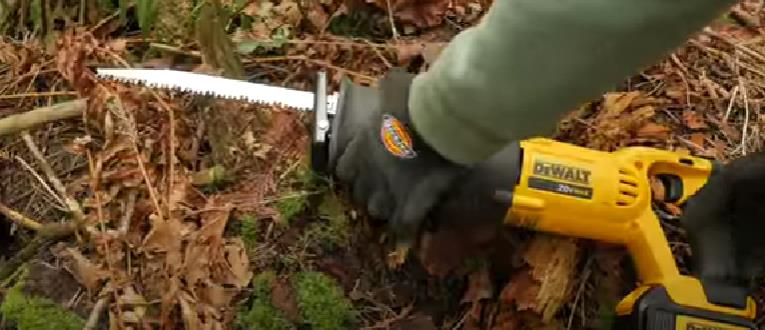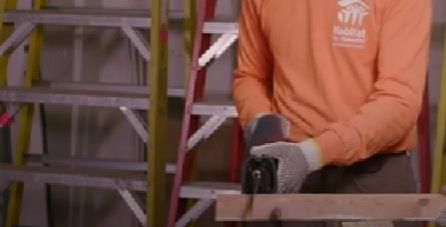Reciprocating saws are powerful tools for cutting through rigid materials such as wood, plastic, and metal. While they can be instrumental in various situations, they must be used carefully. Before using a reciprocating saw, ensure you know and follow the proper reciprocating saw safety rules.
This can help you avoid serious injuries arising from inappropriate tool use or handling. Even though reciprocating saws are strong and valuable tools for many construction workers, some risks should be considered.
In this article, I’ll talk about some of the best ways to stay safe when using a reciprocating saw. By reading up on these pointers, you may ensure that your next project is done safely and efficiently.
Reciprocating Saw Safety Precautions: What Should Be Taken?

Reciprocating saws are effective equipment for cutting a variety of materials. The following steps should be taken to guarantee safe operation:
- Wear PPE (Personal Protective Equipment): Always wear safety glasses and earplugs, and think about work gloves to improve your grip.
- Check the saw before use: Before using the saw, make sure that the saw is in good working condition. Examine the saw for loose parts and evidence of wear and tear, and make sure it is in good operating order.
- Use the Proper Blade: Select the proper blade for the job and ensure it is properly fixed.
- Keep a Firm Grip: Keep a tight grip on the saw with both hands at all times.
- Follow Manufacturer Guidelines: Read the operator’s manual and follow the manufacturer’s directions and recommended operating practices.
- Avoid Excessive Force: Don’t apply excessive force while cutting can cause the blade to bind or break.
- Avoid awkward positions: Avoid awkward positions that could cause wrist strain or cause you to lose control of the saw.
- Use both hands: To maximize stability and control, use both hands to operate the saw.
- Avoid kickback: Maintain a safe distance between the blade and your body, and be wary of kickback.
- Disconnect power: Always turn off the power before changing blades or adjusting the saw.
- Secure the workpiece: Make sure it is clamped or held in place, so it doesn’t move while cutting.
Following these reciprocating saw safety rules when using a reciprocating saw can make it less likely that you will get hurt or hurt someone else.
What Are Some Common Injuries That Can Occur When Using A Reciprocating Saw?
A reciprocating saw is a powerful tool that can make quick work of many home improvement projects. However, as with any power tool, there is a risk of injury if the saw is used improperly.
Some of the most common injuries that can occur when using a reciprocating saw include. And here I am also sharing how to protect you these injury.
1. Cuts and Lacerations:
The blade of a reciprocating saw is very sharp and can easily cause cuts and lacerations if it comes into contact with skin. Always wear gloves and long sleeves when using a reciprocating saw to protect your skin.
2. Eye Injuries:
The blade of a reciprocating saw can kick up dust and debris, which can easily get into your eyes and cause irritation or even more serious injuries. Always wear safety goggles when using a reciprocating saw.
3. Hearing Damage:
The loud noise generated by a reciprocating saw can damage your hearing if you are not wearing ear protection. Always wear earplugs or earmuffs when using a reciprocating saw.
4. Vibration Injuries:
The vibration of a reciprocating saw can cause hand-arm vibration syndrome (HAVS), a condition that can lead to numbness, tingling, and pain in the hands and arms. Always hold the saw firmly with both hands to minimize vibration.
5. kickback Injuries:
If the blade of a reciprocating saw gets bound up in the material you are cutting, it can kick back violently, causing serious injuries. Always keep a firm grip on the saw and be prepared to stop the blade if it starts to bind.
If you are using a reciprocating saw, take the time to familiarize yourself with the tool and follow all reciprocating saw safety precautions. Doing so will help you avoid common injuries and have a safe and successful experience.
How Can You Avoid Kickback When Using A Reciprocating Saw?

When using a reciprocating saw, it’s important to keep reciprocating saw safety in mind and avoid things like kickback. Kickback happens when the saw blade gets caught on the thing being cut and is thrown back at the person using the saw. This can be a dangerous situation, so it is important to take precautions to avoid it.
There are a few things you can do to avoid kickback when using a reciprocating saw:
- Use a blade with a negative rake angle. This will help prevent the blade from getting caught on the material being cut.
- Keep the blade sharp. A dull blade is more likely to catch on the material and cause kickback.
- Use a saw with a variable speed trigger. This will allow you to control the speed of the blade, which can help prevent kickback.
- Be aware of your surroundings. If you are cutting in a tight space, be aware of what is behind the material you are cutting. If there is anything that the blade could catch on, it could cause kickback.
If you follow these tips, you should be able to avoid kickback when using a reciprocating saw.
How Should You Deal with Reciprocating Saw Kickback?

If you’re using a reciprocating saw and feel kickback, it’s important to take action immediately. Kickback is when the blade of the saw gets caught on something and is forced back towards the user. This is extremely dangerous and can result in serious injury.
If you feel kickback while using a reciprocating saw, the first thing you should do is release the trigger. This will stop the blade from moving and prevent further kickback.
Next, use your other hand to support the saw and guide it away from your body. Finally, turn off the saw and inspect the blade to see if it’s damaged. If the blade is damaged, it will need to be replaced before you can use the saw again.
Kickback is a serious hazard when using a reciprocating saw. However, by following the steps above, you can stay safe and avoid injury.
Reciprocating Saw Safety FAQ
How do you take care of a reciprocating saw?
You should do a few daily things to keep your reciprocating saw in good working order and get the most out of it. Always disconnect the saw before cleaning or doing maintenance. Clean the outside of the saw with a damp cloth, paying extra attention to any parts that are likely to rust.
Check for any worn or damaged parts that need to be replaced. Keep your blade sharp because dull blades can make a lot of noise and vibration and can’t cut as well. Lastly, use a light oil or aerosol spray to lubricate all moving parts regularly to keep them in good shape and running smoothly.
Can a reciprocating saw overheat?
A reciprocating saw can overheat. The saw’s motor works hard and generates a lot of heat while operating. If you don’t take care of the saw properly or use it for a long time without letting it cool down, heat can build up and cause it to overheat. To help prevent overheating, ensure your saw is adequately maintained and serviced regularly.
Sum Up
The reciprocating saw is powerful and helpful equipment, but it may also be hazardous if not used properly. We hope that this overview of reciprocating saw safety recommendations has provided you with the information you need to use your instrument safely.
Always wear safety equipment when using a reciprocating saw and keep an eye on the blade at all times. If you follow these procedures every time you use your saw, you will be able to benefit from its benefits without putting yourself in danger.


5 thoughts on “11 Must-Know Reciprocating Saw Safety Tips”
Comments are closed.